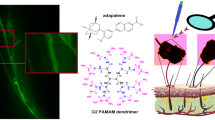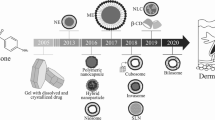Abstract
In order to improve the therapeutic index of adapalene, a new drug under development for the treatment of acne, site-specific delivery to the hair follicles using 50:50 poly(DL-lactic-co-glycolic acid) microspheres as particulate carriers was investigated in vitro and in vivo. The percutaneous penetration pathway of the microspheres was shown to be dependent on their mean diameter. Thus, after topical application onto hairless rat or human skin, adapalene-loaded microspheres (5-µm diameter) were specifically targeted to the follicular ducts and did not penetrate via the stratum corneum. The in vitro release of adapalene from the microspheres into artificial sebum at 37°C was controlled and faster than the in vivo sebum excretion in humans. Aiming to reduce either the applied dose of drug or the frequency of administration, different formulations of adapalene-loaded microspheres were evaluated in vivo in the rhino mouse model. A dose-related comedolytic activity of topical formulations of adapalene-loaded microspheres was observed in this model. Furthermore, by applying a site-specific drug delivery system (0.1% adapalene) every other day or by administering a 10-fold less concentrated targeted formulation (0.01%) every day, a pharmacological activity equivalent to a daily application of an aqueous gel containing drug crystals (0.1% adapalene) was observed. Since an aqueous gel containing 10% adapalene-loaded microspheres was not irritating in a rabbit skin irritancy test, this formulation was applied onto forearms of human volunteers. Site-specific drug delivery was further evidenced by follicular biopsy. These results support the view that follicular drug targeting using 5-µm polymeric microspheres may represent a promising therapeutic approach for the treatment of pathologies associated with pilosebaceous units.
Similar content being viewed by others
REFERENCES
J. Kao, J. Hall, and G. Helman. In vitro percutaneous absorption in mouse skin: Influence of skin appendages. Toxicol. Appl. Pharmacol. 94:93–103 (1988).
J. C. Keister and G. B. Kasting. The use of transient diffusion to investigate transport pathways through skin. J. Control. Rel. 4:111–117 (1986).
J. Wepierre, O. Doucet, and J. P. Marty. Percutaneous absorption of drugs in vitro: Role of transepidermal and transfollicular routes. In R. C. Scott, R. H. Guy, and J. Hadgraft (eds.), Prediction of Percutaneous Penetration, Methods, Measurements, Modelling, IBC Technical Services, London, 1990, pp. 129–139.
B. Illel, H. Schaefer, J. Wepierre, and O. Doucet. Follicles play an important role in percutaneous absorption. J. Pharm. Sci. 80:424–427 (1991).
F. Hueber, J. Wepierre, and H. Schaefer. Percutaneous absorption of hydrocortisone and testosterone in vivo: Role of transepidermal and transfollicular routes. In J. Brès and G. Panis (eds.), Pharmacocinétique: de la Recherche à la Clinique, John Libbey Eurotex, 1992, pp. 204–209.
J. F. G. Ebling and W. J. Cunliffe. Disorders of the sebaceous glands. In R. H. Champion, J. L. Burton, and F. J. G. Ebling (eds.), Textbook of Dermatology, Fifth Edition, Vol. 3, Blackwell Scientific, Oxford, 1992, pp. 1699–1707.
H. Schaefer, F. Watts, C. Papantoniou, and C. Mahieu. Composition cosmétique ou pharmaceutique contenant des microsphères de polymères ou de corps gras chargées d'au moins un produit actif. European Patent 0 375 520 (1989).
H. Schaefer, F. Watts, J. Brod, and B. Illel. Follicular penetration. In R. C. Scott, R. H. Guy, and J. Hadgraft (eds.), Prediction of Percutaneous Penetration, Methods, Measurements, Modelling, IBC Technical Services, London, 1990, pp. 163–173.
M. Verschoore, A. Langner, H. Wolska, S. Jablonska, J. Czernielewski, and H. Schaefer. Efficacy and safety of topical CD 271 alcoholic gels in the topical treatment of acne vulgaris. Br. J. Dermatol. 124:368–371 (1991).
B. Shroot, J. Eustache, J. M. Bernardon, and W. R. Pilgrim. New retinoids for the treatment of disorders of epidermal differentiation. In S. Sarel, R. Mechoulam, and I. Agranat (eds.), Trends in Medicinal Chemistry '90, Blackwell Scientific, Oxford, 1992, pp. 419–424.
R. Arshady. Preparation of biodegradable microspheres and microcapsules. 2. Polylactides and related polyesters. J. Control. Rel. 17:1–22 (1991).
M. Bouclier, A. Chatelus, J. Ferracin, C. Delain, B. Shroot, and C. Hensby. Quantification of epidermal histological changes induced by topical retinoids and CD 271 in the rhino mouse model using a standardized image analysis technique. Skin Pharmacol. 4:65–73 (1991).
J. S. Strauss, D. T. Dowing, and M. E. Stewart. Sebum excretion in relation to age. J. Appl. Cosmetol. 3:257–266 (1985).
Author information
Authors and Affiliations
Rights and permissions
About this article
Cite this article
Rolland, A., Wagner, N., Chatelus, A. et al. Site-Specific Drug Delivery to Pilosebaceous Structures Using Polymeric Microspheres. Pharm Res 10, 1738–1744 (1993). https://doi.org/10.1023/A:1018922114398
Issue Date:
DOI: https://doi.org/10.1023/A:1018922114398




